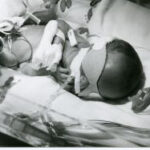There are simple and gentle ways to discipline babies and help them learn right from wrong.
5 Effective Ways to Discipline Babies
Routine and Schedules
Parents can easily become subject to a baby’s demanding schedule. It’s important to establish a routine for babies, which is one their first forms of discipline, according to the American Academy of Pediatrics.
The routine will help soothe and comfort a newborn, as they come to expect certain reactions or activities at certain times. The American Academy of Pediatrics does recommend that parents be flexible with the routine, as the baby and the family gently ease into it.
Later effects of a routine and structure can be seen when a child is older. My son, for example, knows his bedtime routine and he will remind me if I forgot a step. Even at three, there is still a comfort in having a routine.
Positive Reinforcement: Visual Cues
Baby’s behaviors can be positively reinforced with gestures as simple and easy as a parent’s or caregiver’s smile. Smiling when baby holds his or her own bottle, or sits up on their own are small ways to show a baby a form of positive reinforcement, the smile of an approving parent. Babies, and later toddlers and preschoolers need positive reinforcement as part of an overall discipline approach. They need to know when they’ve done things right.
For example, potty training did not happen consistently for my son until I introduced a book of reward stickers. He loves receiving a sticker after using the toilet, and will give one to anyone else in the family who uses the toilet. On some days he expands the rewards to “eat sticker” and “nap sticker.” If you’re thinking this only worked because the kid did not have stickers, that wasn’t it. He has books of stickers. But he knew that these were special and would only get one when he successfully used the toilet.
Removing Problems: Proactive Discipline
One way to eliminate the need to constantly tell a baby, “no” is to remove problematic items from a room. When our baby was on the floor he would always reach out and try to grab anything he could get his little hands on. We removed the coffee table from the living room, giving him more room to explore and play, and less chance to play with items on the table that we did not want him to touch.
The American Academy of Pediatrics considers this proactive discipline, which is an important form of discipline for babies and toddlers. By removing an object that can cause a problem, you can eliminate some negative or dangerous behaviors before they occur.
Verbal Reinforcement
“Good boy” and “good job” are two of my most popular phrases I used with my son, especially when he was a baby. Now that he is older, he understands more words, and I use a combination of consequences and rewards to discipline him. When he was a baby, he often heard “good job” when he had a good feeding, or rolled over onto his back from his belly. Praising daily milestones and events, as well as the bigger milestones helps to instill self-esteem and self-worth in even the smallest of children.
Activities are Bad, Babies Are Not
It’s imperative that parents give their children positive building blocks for self-esteem. When a baby does something wrong, focus on the behavior as being bad, not the child. Continuing this disciplinary approach when babies grow into toddlers and preschoolers will help them learn how to behave, and they will not feel bad about themselves.
Consistent Parenting
Parents need to be consistent with their reactions, and subsequent approval or disapproval to a baby’s behavior. Getting both parents on the same page can be more of a challenge, especially when baby duties are split up.
Both parents need to try to follow the same rules as each other, to maintain a sense of order and stability. In a loving and stable environment, the child is more likely to respond to discipline, according to the American Academy of Pediatrics.
Sources
American Academy of Pediatrics Guidance for Effective Discipline, http://aappolicy.aappublications.org/cgi/reprint/pediatrics;101/4/723.pdf
http://www.beachpsych.com/pages/cc62.html
Personal Experience

